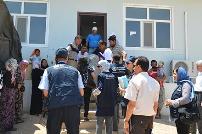 By June 2013, according to the United Nations Office of the High Commissioner for Refugees (UNHCR), the number of registered Syrian refugees in neighbouring countries exceeded 1.8 million and the current situation is now viewed as one of the worst humanitarian crisis and conflicts the world has seen in decades.23 July 2013, Cairo - The current humanitarian crisis in Syria poses a grave risk of epidemics among the Syrian refugees who are currently displaced in the neighbouring countries of Iraq, Jordan, Lebanon and Egypt.
By June 2013, according to the United Nations Office of the High Commissioner for Refugees (UNHCR), the number of registered Syrian refugees in neighbouring countries exceeded 1.8 million and the current situation is now viewed as one of the worst humanitarian crisis and conflicts the world has seen in decades.23 July 2013, Cairo - The current humanitarian crisis in Syria poses a grave risk of epidemics among the Syrian refugees who are currently displaced in the neighbouring countries of Iraq, Jordan, Lebanon and Egypt.
As the health situation of the Syrian refugees in these countries continues to deteriorate, the health systems of the host countries risk being overwhelmed in the face of a continuous influx of refugees and rising temperatures during the summer months. With thousands of Syrians crossing the borders each day, there is a potential risk that diseases that are prevalent inside Syria can be transmitted or introduced into neighbouring countries. The situation may deteriorate if public health prevention and control measures are not scaled up urgently in these countries.
WHO has been supporting national health authorities in countries hosting displaced Syrian refugees since the beginning of this crisis to improve the health situation of the Syrian refugees. In view of the current epidemic risk, WHO has scaled up its epidemic preparedness and readiness measures across all the neighbouring countries of Syria that have been affected by the crisis.
As part of these measures, an epidemic risk assessment was carried out by WHO in northern Iraq, which is currently the home to approximately 159 000 Syrian refugees. The team visited the Domiz camp in the Dohuk governorate of northern Iraq, which is the largest refugee camp for the Syrian refugees in the region and currently home to over 80 000 displaced Syrian populations. The environmental risk factors for disease transmission and the living conditions of the refugees were assessed.
The health status of the refugees was reviewed through analysis of epidemiological information. The assessment of WHO led to identifying potential epidemic risk from a number of diseases – cholera, Shigellae dysenteriae, typhoid fever, acute viral hepatitis, as well as measles in the Syrian refugees displaced in various camps and informal settlements during the current summer months. The ability and capacity of local health systems to early detect, manage and rapidly control any potential epidemics were also assessed by the WHO team during this mission. The mission concluded with elaborating a joint plan with the local health authorities of northern Iraq on improving public health preparedness, strengthening early warning surveillance and enhancing field investigation and rapid control capacity on the ground for detection, prevention and control of any potential epidemic that may occur among the Syrian refugee populations.
Additional activities have been planned with the local health authorities over the next three months that include training of first-line responders, pre-positioning medicines and medical supplies, and ensuring sufficient laboratory capacity to identify infectious diseases as part of implementing this summer outbreak containment plan.
Related links
WHO providing health care to Syrian refugees in and outside the camps



